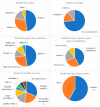Why a New Research Agenda on Green Spaces and Health Is Needed in Latin America: Results of a Systematic Review
- PMID: 34072319
- PMCID: PMC8198896
- DOI: 10.3390/ijerph18115839
Why a New Research Agenda on Green Spaces and Health Is Needed in Latin America: Results of a Systematic Review
Abstract
(1) Background: Increasing and improving green spaces have been suggested to enhance health and well-being through different mechanisms. Latin America is experiencing fast population and urbanization growth; with rising demand for interventions to improve public health and mitigate climate change. (2) Aim: This study aimed to review the epidemiological evidence on green spaces and health outcomes in Latin America. (3) Methods: A systematic literature review of green spaces and health outcomes was carried out for studies published in Latin America before 28 September 2020. A search strategy was designed to identify studies published in Medline via PubMed and LILACS. The search strategy included terms related to green spaces combined with keywords related to health and geographical location. No time limit for the publication was chosen. The search was limited to English, Spanish, Portuguese, and French published articles and humans' studies. (4) Findings: This systematic review found 19 epidemiological studies in Latin America related to green spaces and health outcomes. Nine studies were conducted in Brazil, six in Mexico, three in Colombia, and one in Chile. In terms of study design, 14 were cross-sectional studies, 3 ecological, and 2 cohort studies. The population included among the studies ranged from 120 persons to 103 million. The green space definition used among studies was green density or proximity (eight studies), green presence (five studies), green spaces index (four studies), and green space visit (two studies). The health outcomes included were mental health (six studies), overweight and obesity (three studies), quality of life (three studies), mortality (two studies), cardiorespiratory disease (one study), disability (one study), falls (one study), and life expectancy (one study). Eleven studies found a positive association between green spaces and health, and eight studies found no association. (5) Conclusion: This systematic review identified 19 epidemiological studies associating green spaces and health outcomes in Latin America. Most of the evidence suggests a positive association between green spaces and health in the region. However, most of the evidence was supported by cross-sectional studies. Prioritizing longitudinal studies with harmonized exposure and outcome definitions and including vulnerable and susceptible populations is needed in the region.
Keywords: Latin-America; epidemiology; green spaces; health; systematic review.
Conflict of interest statement
There are no competing financial interests. Authors hold sole responsibility for the views expressed in the manuscript, which may not necessarily reflect the opinion or policy of PAHO.
Figures
Similar articles
-
Home treatment for mental health problems: a systematic review.Health Technol Assess. 2001;5(15):1-139. doi: 10.3310/hta5150. Health Technol Assess. 2001. PMID: 11532236
-
The measurement and monitoring of surgical adverse events.Health Technol Assess. 2001;5(22):1-194. doi: 10.3310/hta5220. Health Technol Assess. 2001. PMID: 11532239
-
Inhaled mannitol for cystic fibrosis.Cochrane Database Syst Rev. 2018 Feb 9;2(2):CD008649. doi: 10.1002/14651858.CD008649.pub3. Cochrane Database Syst Rev. 2018. Update in: Cochrane Database Syst Rev. 2020 May 1;5:CD008649. doi: 10.1002/14651858.CD008649.pub4. PMID: 29424930 Free PMC article. Updated.
-
Seroprevalence of hepatitis C virus among people living with HIV/AIDS in Latin America and the Caribbean: a systematic review.BMC Infect Dis. 2016 Nov 9;16(1):663. doi: 10.1186/s12879-016-1988-y. BMC Infect Dis. 2016. PMID: 27829381 Free PMC article.
-
Burden of Heart Failure in Latin America: A Systematic Review and Meta-analysis.Rev Esp Cardiol (Engl Ed). 2016 Nov;69(11):1051-1060. doi: 10.1016/j.rec.2016.04.054. Epub 2016 Aug 21. Rev Esp Cardiol (Engl Ed). 2016. PMID: 27553287 English, Spanish.
Cited by
-
Association between Active Use of Urban Green Spaces and Well-Being in Adults Aged 18-65 Years: A Systematic Review.J Health Pollut. 2024 Nov 27;12(1-4):016002. doi: 10.1289/JHP1040. eCollection 2024 Dec. J Health Pollut. 2024. PMID: 40342951 Free PMC article. Review.
-
Impact of urban greening on population health in sub-Saharan Africa: a scoping review protocol.BMJ Open. 2024 Oct 22;14(10):e087638. doi: 10.1136/bmjopen-2024-087638. BMJ Open. 2024. PMID: 39438109 Free PMC article.
-
Users' safety perceptions from crime in relation to park type and user gender in Mexico.J Healthy Eat Act Living. 2025 Feb 1;5(1):86-96. eCollection 2025. J Healthy Eat Act Living. 2025. PMID: 40060771 Free PMC article.
-
Mobility Infrastructures and Health: Scoping Review of studies in Europe.Public Health Rev. 2024 May 22;45:1606862. doi: 10.3389/phrs.2024.1606862. eCollection 2024. Public Health Rev. 2024. PMID: 38841179 Free PMC article.
References
-
- Riojas-Rodríguez H., da Silva A.S., Sangrador J.L.T., Moreno-Banda G.L. Air pollution management and control in Latin America and the Caribbean: Implications for climate change. Rev. Panam. Salud Pública. 2016;40:150–159. - PubMed
-
- NNaghavi M., Abajobir A.A., Abbafati C., Abbas K.M., Abd-Allah F., Abera S.F., Aboyans V., Adetokunboh O., Afshin A., Agrawal A., et al. Global, regional, and national age-sex specifc mortality for 264 causes of death, 1980–2016: A systematic analysis for the Global Burden of Disease Study 2016. [(accessed on 12 April 2021)];Lancet. 2017 390:1151–1210. doi: 10.1016/S0140-6736(17)32152-9. Available online: https://www.scopus.com/inward/record.uri?eid=2-s2.0-85031727040&doi=10.1.... - DOI - PMC - PubMed
-
- Watts N., Amann M., Arnell N., Ayeb-Karlsson S., Belesova K., Boykoff M., Byass P., Cai W., Campbell-Lendrum D., Capstick S., et al. The 2019 report of The Lancet Countdown on health and climate change: Ensuring that the health of a child born today is not defined by a changing climate. Lancet. 2019;394:1836–1878. doi: 10.1016/S0140-6736(19)32596-6. - DOI - PMC - PubMed
-
- Egorov A.I., Mudu P., Braubach M., Martuzzi M. Urban Green Spaces and Health: A Review of the Evidence. World Health Organization; Copenhagen, Denmark: 2016.
Publication types
MeSH terms
LinkOut - more resources
Full Text Sources



